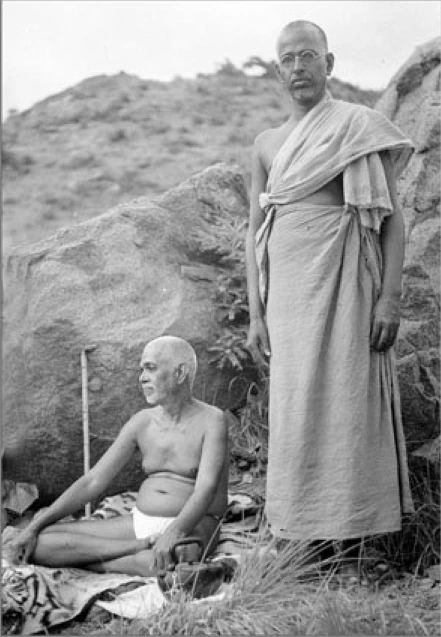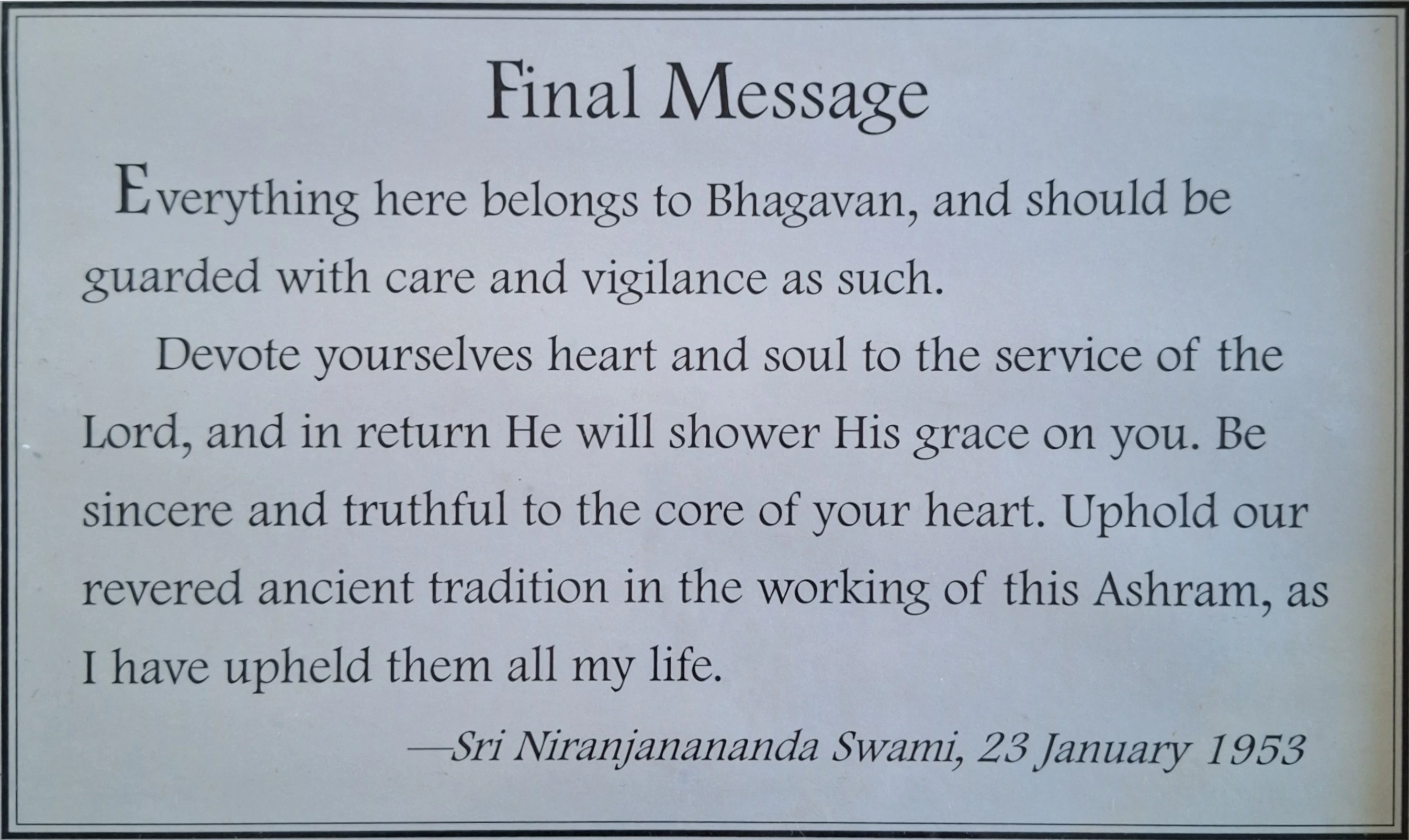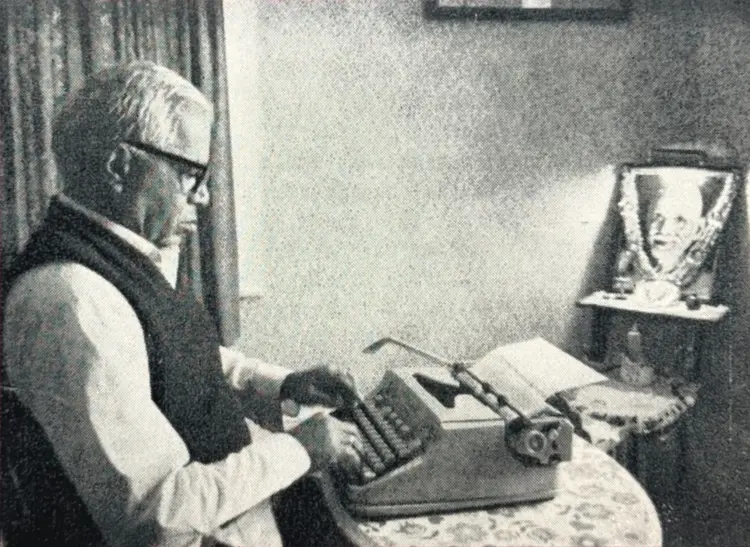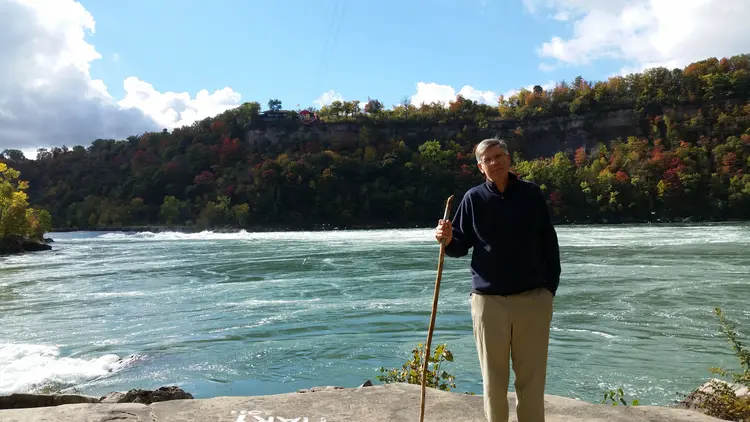May/Jun/2024







Swami Niranjanananda
In the Service of Sri Bhagavan
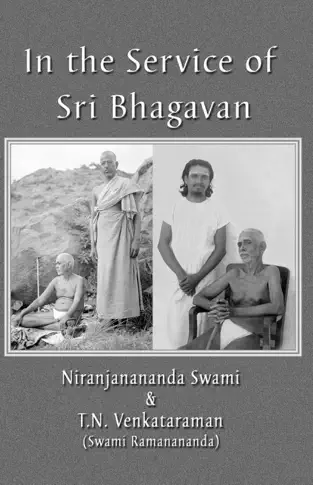
Sri Ramana Maharshi's younger brother, Nagasundaram came to stay permanently with his sage brother at Arunachala in 1917, at the age of 32. He had lost his wife after the birth of their child Venkataraman, and leaving his child in the loving care of his sister Alamelu, he formally took sannyasa in 1918, taking the name Niranjanananda. Also known as Chinnaswami, with his administrative adeptness and insights, and fully supported by the grace of Sri Bhagavan, he admirably managed the ashrama as the Sarvadhikari from Oct. 1931 until his absorption in 1953. In this excerpt from the book In the Service of Sri Bhagavan, written by his granddaughter Smt. Mangalam, we see the love that this great karma yogi had for Sri Bhagavan, and how he laid the groundwork to ensure that Ramanasramam remain a center for devotees for centuries to come. From the daily supervision of ashram activities, to the ashram book depot, to the construction and consecration of Mother's temple, Chinnaswami's complete surrender to Sri Bhagavan was evident in every facet of his inspiring life.
In the 1920s the works of Bhagavan such as Arunachala Stuti Panchakam, Appala Pattu, prose translation of Adi Shankara's Vivekachudamani, etc. were published by various devotees such as Echammal, Narayana Reddy and Annadurai and were sold in the northeast corner mandapam of the Arunachaleswara Temple under the seal of Ramaneeyavaani Pustakalayam. When Chinnaswami took charge of the Ashram administration, Sri Ramanasramam Book Depot started functioning in a building next to the Ashram office. Ashram publications in various languages were available there for devotees. Chinnaswami fondly kept with him three Tamil books and would read them off and on. They were: Ramana Vijayam, Nultirattu (The Collected Works of Sri Ramana Maharshi) and Nan Yaar (Who am I?). He advised devotees to read these three books. He knew by heart Bhagavan's poems and songs and his teachings with meaning, and would recite them regularly. He had a small notebook in which he had written all the poetical works of Bhagavan and was using it for his daily recital. In it, he had also noted some other details such as his father's death anniversary, etc. and the same is preserved in the Ashram Archives now. He was a living example of karma yoga. He said that Bhagavan was like fire and advised people who came to the Ashram to remember that Bhagavan was no ordinary person – that he was Siva and people should be mindful when they approached him. He would add, “We are all one family and we all have one god.” Regarding people who wander in search of a guru, he would say, “In order to see the sun does one need a lamp?” Indeed, is not Bhagavan the spiritual sun “brighter than a thousand suns”?
In 1948 the construction of the Matrubhuteswara Temple was completed after ten years of meticulous hard work by everyone concerned, especially Chinnaswami, with Bhagavan's blessings. Chinnaswami went to Madras with Bhagavan's consent to organise the ingredients necessary for the kumbhabhishekam (consecration of the Temple). He stayed at Jayadevlal Dave's house for 22 days. He personally invited many people to the event. It was the crowning glory of Chinnaswami's work for the Ashram. It required great strength of mind and courage to weather many a storm of difficulties, criticism and obstacles and bring the sacred task to a successful completion. The kumbhabhishekam ceremony took many months of preparation and Chinnaswami consulted many knowledgeable well-wishers to ensure that the entire ceremony was in strict accord with Vedic injunctions.
The kumbhabhishekam ceremony began on the 13th and concluded on the 17th of March 1949. There were four full days of Vedic chanting with numerous homas on the 13th, with hundreds of Vedic scholars and pundits participating. The rituals were completed on the 17th of March. Sri Bharati Krishna Tirtha, the Sankaracharya Swamiji of Puri Mutt arrived to attend to the details of kumbhabhishekam rituals, as he had indicated during his earlier visit. Some 10,000 meals were served. People were astounded at the magnitude of the celebrations. Bhagavan himself supervised this seva. A great many cooks and helpers and the service of the police were also enlisted and firefighters were asked to standby in readiness to see that such a largely attended event went smoothly.
On the first day, Bhagavan came along with the purna kalasam to the New Hall and then went straight to the Mother's Temple. He touched all the sacred items consecrated to the temple, and then came to the New Hall where he sat on the new granite sofa that had been prepared for him.
Chinnaswami was garlanded in honour of his efficient, impeccable organisation of the kumbhabhishekam. A great devotee of Bhagavan, Nellore Sambasiva Rao, wanted to do pada-puja to Chinnaswami and took Bhagavan's consent. After Bhagavan sat on the granite sofa, Chinnaswami was brought in and made to sit in an appropriate place. Chinnaswami started to tremble as he said, “You people think you can trick me. No way, I will not accept pada puja. It is only for those who have no dehatma bhava (‘I am the body’ sense.) I don't deserve pada puja.” He then got off the stage and walked away. People tried to force him to stay and he eventually relented by saying, “Bhagavan's silver footwear (donated by a devotee) is kept near the lingam. Go and bring them and do puja to them.” The symbolic silver-plated wooden footwear was brought and puja was done to them. Chinnaswami accepted the ochre robe as Bhagavan's prasadam after putting it to his eyes. Then in a tone of humility and sternness he said “In Bhagavan's sannidhi all respect, pujas and prostrations should be made to Bhagavan alone. It is only under pressure of devotees I accepted this for once, but never again will I do that.” At the end, Chinnaswami gave gifts to all those who assisted in making this momentous event a grand success.
Chinnaswami took great care to ensure that Bhagavan was free as far as possible from any inconveniences. In earlier days when Bhagavan left the dining hall, a devotee would be waiting so that he or she could take the meal off Bhagavan's leaf plate as a token of Bhagavan's special grace. When this came to Bhagavan's attention, though he had great difficulty in getting up after the meals due to arthritis in his knees, he started getting up with the leaf in his hand to throw it on the communal pile. Chinnaswami eventually persuaded Bhagavan to leave his leaf on the condition that everyone also would do likewise, that his leaf would be thrown out along with all other leaves and that none would henceforth eat on his leaf. Since then, to this day, all the used leaf plates are left behind to be collected and thrown out together.
One devotee Uma, wife of Somasundaram Pillai, named Chinnaswami ‘clothes beating stone’ or whipping board because, by Bhagavan's grace, he put up cheerfully with all the complaints that people made about the management. Service to the Ashram was Chinnaswami's life mission. He
treated everybody with respect and compassion. He fully understood Bhagavan's uniqueness and was utterly loyal in his devotion to him. He ran the Ashram solely with the donations given by devotees. He never accepted donations unless they were given with complete faith and trust in Bhagavan. He had flaming integrity regarding Ashram accounts. He laid the foundation for the eventual phenomenal growth of the Ashram and he was aware that it was due to Bhagavan's grace. He considered himself the elder brother of devotees as well as the servant of all. People felt free to come to the Ashram and receive darshan to their hearts' content. He never took any credit for the efficient management of the Ashram for he knew and said that it was due to Bhagavan's śakti. He was a stickler for discipline and enforced it in the Ashram. Even those who resented it admired his fierce sense of duty. Of course, Bhagavan himself was a perfect model in complying with the Ashram discipline.
Bhagavan never cared for his body but Chinnaswami was concerned about Bhagavan's health and would try to restrict hours of admission to the Old Hall. However, Bhagavan would not countenance such a limit imposed on devotees' freedom to approach him.
The years 1948-50 saw Chinnaswami in great physical and mental stress and anguish. There was a good deal of building activity and visitors were coming in ever-increasing waves, but funds were very inadequate. There was an active group of people opposed to him. What caused him the greatest distress was the fact that Bhagavan had developed a most excruciating form of cancer around his left elbow and though all systems of therapies were tried through the best experts, Bhagavan's health deteriorated day after day. However, by Bhagavan's grace and inspired by Bhagavan's own example, Chinnaswami stood like a rock and faced all the problems with tremendous fortitude. ,
On the 14th of April 1950, Bhagavan attained Mahanirvana. He was Chinnaswami’s brother, father, mother, prop, guru and everything. Though Bhagavan remained as an abiding, effulgent presence and the light that he ever was, Chinnaswami sorely missed that benign physical presence.
On the 30th of September 1950, under the supervision of Chinnaswami, a management committee with seventeen members was constituted. In 1952 Chinnaswami developed an intestinal disease and chest pain; He suffered from considerable physical agony. His sister who was addressed by all devotees as ‘Athai’ (aunty) passed away on 3rd January 1953, from which he concluded that his end too was nearing. One day he called close relatives and devotees to hear his last instructions. He said, “I am going away with stainless hands and a fulfilled heart. I have never touched a paisa of the Ashram for my personal possession. Everything here, every stick and stone, belongs to Bhagavan. You have to treat them with devotion. You must give your heart and mind to Bhagavan. He will shower your heart with grace. Be truthful and honest. In doing your Ashram duties you must uphold the virtue of your lineage.”
This final injunction showed Swami Niranjanananda's great dispassion and attitude of complete surrender to Bhagavan. He lived true to the words of the saints: “Except to Him, to no other gods do I pay obeisance.” This great karma yogi left his body on a full moon day, Thursday the 29th of January 1953 at 11.30 pm. His earthly remains were interred in front of the Mother's temple for which he had labored so hard and long. A lingam was consecrated at the site where pujas are performed daily.
Blameless, spotless Chinnaswami who lived at the feet of the great sage is now in constant silence having been absorbed in his guru. His life is a source of inspiration in the service of Bhagavan and his devotees.







In Search of Self
People say that New York City is no place for the pursuit of peace and happiness, as there are many distractions. But I have been so completely submerged in Bhagavan's Grace that I have no time for anything else but to meditate on Bhagavan. The advent of Guru Ramana at Arunachala is the signal to mankind that everyone can practice his path without leaving his home or job. If we can succeed in turning our gaze inward and spend a few minutes doing it regularly every day at a fixed hour, both in the morning and night, we shall surely be launched on that wonderful path which is the summum bonum of human life. He taught the Direct Path of Self-Enquiry and asked us to practice WHO AM I? This is the path that does not require any ritualistic discipline on the part of the follower. It is immaterial to which religion one belongs. All religions of the world teach us the same thing: how to find the Self within ourselves. The most important thing is to apply the teachings to our lives through constant practice.
In the modern age when there is so much individual and group skepticism towards the spiritual path, it would be worthwhile to ponder and look into our inner selves. If we turn our attention to the Center from where the sound or breath emanates, we shall find that it is the Heart on the right side of the chest. By meditating on it we can easily slow down our thought patterns and the time will come when peace and bliss will inundate our whole being. This is the most simple and direct method by which we can succeed in discarding the ignorance of the mind and achieve a wonderful glimpse of peace and tranquility.
Even without ever seeing Bhagavan physically, I find my whole life transformed by Him. It is Bhagavan's Grace and Blessings that have brought me to the present phase of life. My childhood dream of knowing the secrets of spiritual life has come true and from that moment in Darjeeling, Himalayas, when Bhaga¬van's Name came into my life, I have always considered Him to be my Guru. But I had to wait for thirteen years until Bhagavan Sri Ramana Maharshi gave me darshan in a dream. Since then, I have become His servitor and have been on the road to Arunachala. I don't think I could have been fortunate enough to drink the nectar of Bhagavan's teaching if I had seen Him in the body. No amount of lectures or book reading could have given me that insight into the Self that the very Name of Bhagavan has bestowed upon me.
For me, any place and time is good for meditation. Bhagavan's Grace has so overwhelmed me that I ride the crest of the wind and travel to the nth place. But where is the nth place in our wide world? That is right in our Heart. If we simply withdraw our attention from the external world and turn to the Heart, we shall find ourselves diving deep into the river of peace and bliss. At any time, any place and under any circumstances, we can take a few minutes from our busy life and spend them in meditation and saturate ourselves with peace and bliss. If we chase the shadow, we shall never succeed in catching it. But if we turn our back on it, like a faithful servant the shadow will follow us wherever we go. If we pour oil on fire, we can't extinguish it. Similarly, by craving for and fulfilling our desires we shall never be able to quench our thirst for enjoyment. Happiness is within and we have to dive deep within to experience it. When we dig a well for water, we don't go digging just anywhere. We look around and select a place that has the potential for it. Then we start digging and go on doing it until we find not just a trace of water, but the source of continuous supply. So, we must start digging for the water of happiness if we want to quench our spiritual thirst.
When I begin to describe my deep experiences, words freeze and sentences lose their power to communicate. My life is now so much saturated in Bhagavan that I don't need to read books or cultivate austere disciplines. The very Name of Bhagavan is the boat for me on which I can cross the sea of ignorance. So much power flows to the Heart that I feel like opening its floodgates and letting the world be drowned in Arunachala's peace and bliss.
Nothing in my life is secret. Whatever comes to me from Bhagavan belongs to all. But when the sun rises all the buds do not blossom. Those who are ready to partake of Bhagavan's Grace shall be led to the Ashrama where the Great Guru Ramana abides and will draw peace and bliss to enrich their lives. Guru Ramana is the Self in the Heart and He is ever there to guide us to the Truth.
Bhagavan Ramana asks us to turn within and find out who this "I" is and where it comes from. The Direct Path of Self-Enquiry is the easiest path given to mankind by the silent Sage of Arunachala. By practicing the path of WHO AM I? we can reach the source of power. Do not ask what to believe and what not to believe, what to follow and what not to follow. What is needed is the will to see the Sun of suns and the rest is taken care of. Keep the daily routine of your life, but spare some time for your search. The result will not only be satisfactory but overwhelming.
In the modern age, many think that to travel on the path laid down by the seers and sages from all traditions is not possible, or rather very difficult. But it is not so. Amidst all the travails and trials, we are always the Self, and if we simply dive deep into the Heart and remain immersed in it for a short while each day, we shall soon discover the truth of the teachings. There is no use talking about the color of the water and wrangling over its taste if we have not cared to drink it and experience its true flavor.
The Great Guru, Arunachala Shiva Bhagavan Sri Ramana Maharshi, says about the Heart in these verses:
Since the moment I came to realize the ever-flowing Grace of Bhagavan, surging in my Heart like the mighty Ganga, Scriptures and books have pushed me more and more to the Heart, and it is by the sheer abidance in the Heart that I can experience His Grace and Blessings all the time. It is by going deeper and deeper into the inmost recesses of the Heart that the "I-I" begins to shine and time and space are left far behind. There is nothing but the Ever-Abiding Self in the Heart and my life has taken an entirely new path that words and sentences are incapable of describing. I am abiding in Bhagavan, who is nothing but the Heart. Who is Arunachala Ramana whom I never tire of speaking about? Let me repeat from Bhagavan Sri Ramana Maharshi's own words:
In the recesses of the lotus-shaped Heart of all, beginning with Vishnu, there shines as Absolute Consciousness the Paramatman who is the same as Arunachala or Ramana. When the mind melts with love of Him, and reaches the inmost recess of the Heart wherein He dwells as the Beloved, the subtle eye of pure intellect opens and He reveals Himself as Pure Consciousness.
It is the world of peace and happiness that saturates my entire being and in His Name I walk, move and keep on drinking deep in the Eternal Ramana. He is much more present in me than the sun, the moon and the stars. When I see the sun shining and feel the wind blowing, I am automatically drawn into the Heart where I experience the presence of Bhagavan and I am immersed in that state for a while. The awareness in the Heart very easily draws the mind into the Heart and the world of senses and sight becomes a distant thing.
– April 14th, 1968, Brooklyn, New York, on the 18thanniversary of Sri Bhagavan's Mahasamadhi.
In Search of Self" [1]
Vasiṣṭha’s Yoga
Sage Bhuśuṇḍa reveals how to still the agitations of the mind brought on by desires.
Bhuśuṇḍa: There was a celestial who lived on a hilltop. He was ignorant and devoted to sense pleasure, but he had adopted a religious lifestyle that would ensure a very long life. After a long time, the understanding arose in him that he should attain that state in which there was no birth or death. Having thus made up his mind, he came to me. Having duly worshipped me, the celestial asked me: “These senses, O Lord, are constantly agitated with craving for gratification and they are the source of endless pain and suffering. I have realised this and I take refuge in your feet.
Bhuśuṇḍa replied: You are indeed blessed, O celestial, that you are spiritually awake and you wish to uplift yourself. Your intelligence is fully awakened. Hence, I feel that you will understand my instruction effortlessly. Please listen to what I have to say. What I say is born of long experience.
What appears to us as ‘I’ and ‘the other’ in truth is not your self. For when you look for theses you cannot see them. The conviction that neither ‘I’ nor ‘you’ nor ‘the world’ exists is conducive to happiness, not sorrow. The origin of ignorance cannot be determined. Even after considerable enquiry we are unable to determine whether the world appearance arises from ignorance, or ignorance is born of the world appearance. The two are in fact two aspects of the same thing. Whatever exists is the one infinite consciousness or Brahman; the world appearance is like a mirage, of which it can be said ‘It is’ and ‘It is not.’
The seed for this world appearance is the ego-sense, for this tree of world appearance grows from the ego- sense. The senses and their objects, the various forms of conditioning, heaven and earth with its mountains, oceans, etc., the divisions of time and all the names and forms are different parts of this tree of world-appearance.
When the seed is burnt, it gives rise to nothing. How is this seed burnt? When you enquire into the nature of the ego-sense, you realise that it is not to be seen. This is knowledge. By this fire of knowledge is the ego-sense burnt. By entertaining the notion of ego- sense, it appears to be and gives rise to the world appearance. When this false notion is abandoned, the ego-sense disappears and self-knowledge arises.
In the very beginning of this world appearance, the ego-sense did not exist as a reality. Then how can we believe in the ego-sense, in the reality of ‘I’ and ‘you’ and duality or non-duality? They who seriously and earnestly strive to realise the truth, after having duly received it from the lips of a preceptor and having studied it in the scriptures, easily attain self-knowledge.
What appears to be the world is the expansion of one’s own notions or thoughts (saṅkalpa). It is based on consciousness. It is an optical illusion which has consciousness for it substratum. Hence, it is regarded as both real and unreal. In the bracelet, gold is the truth and bracelet is but an idea or notion. Thus, both the appearance and disappearance of the world illusion are but modifications of the idea. He who has realized this is disinterested in the delights of this world or heaven. This is his last incarnation.
O celestial, you are that Brahman which is homogeneous and undivided and indivisible, like space. You are a knower. Whether you know something or do not, remain free from doubt. When you realize that you are the unborn, infinite consciousness then all ignorance and foolishness cease and this world appearance ceases. Wherever the supreme Brahman exists (and it is infinite and exists everywhere) there rises the world appearance. In a blade of grass, wood, water and in all things in the universe the same Brahman, the infinite consciousness exists. The nature of Brahman is indescribable and indefinable. In it, there is no other and hence it is incomparable. Hence, it is inappropriate to even talk of the nature of Brahman. That which is experienced when this ego-sense ceases is the same Brahman which is attained by one in whom the ego-sense prevails when that one enquires into the nature of the ego-sense. It thereupon dissolves in consciousness.
Where is thy Port, O Soul?
In verse 79 of Aksharamanamalai Sri Bhagavan writes, “Guard me less I flounder storm-tossed like a ship without a helmsman, O Arunachala!” The following poem, written by Dennis on Jan. 1, 1978, is also the plea of the wearied individual soul in a battered vessel, who seeks to cross the turbulent ocean of samsara and longs for refuge in the safe harbor of the Lord.
Where is Thy port, O Lord?
This ship is tattered, sailing long, rudder wavering,
Tossing wearily over the sea.
Where is Thy port, O Lord?
Mast bending, sails withered from unending storms, passionate storms.
Provisions scanty! Keel broken!
Sink or save this ship, O Lord!
Beams splitting at all sides.
To wind and waves, this ship is lost.
Sink it quickly, or save it now, O Lord!
Where is Thy port, O Lord?
Where silent waters welcome, hold firm this longing anchor.
Where tempests cease, waters sleep,
and all is peace; no ripple, no wind.
Oh... where is thy port, O Soul?
[1] Excerpted from pages 121 through 129 of In Search of Self, First edition, 1987.



